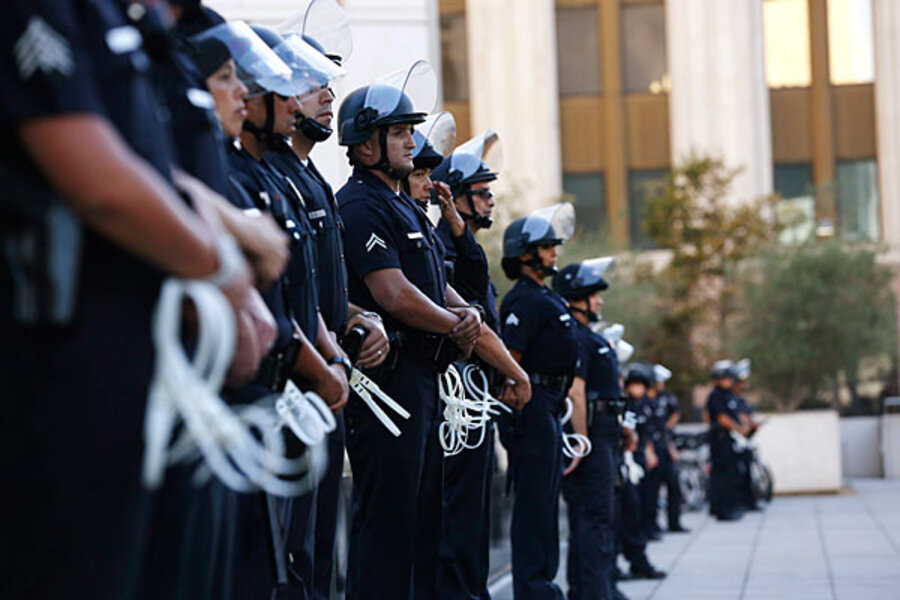Zimmerman verdict protests: Los Angeles police get 'A-plus'
Loading...
| Los Angeles
The Los Angeles Police Department – which has repeatedly come in for its share of scrutiny during the past 20 years – is getting high marks for its handling of community protests in the wake of the George Zimmerman verdict.
“I would give them an A-plus,” says Najee Ali, a prominent black activist who has been a leader of the local protest movement since the Rodney King riots in 1992. LAPD officers “backed off and let us vent when we needed to, and then also got tough in cracking down when outside provocateurs tried to take advantage.”
That restraint came from having long talks ahead of time with activist groups such as the NAACP, the Southern Christian Leadership Conference, Al Sharpton’s National Action Network, and local groups, Mr. Ali and others say.
“They told us ahead of time to not go into the streets, block traffic, or vandalize stores,” says Ali. “So if any of those things began to happen, they knew it was from outside agitators and it was time to crack down,” he says. “Twenty years ago, under [former LAPD Chief] Daryl Gates, they would have come in with guns blazing and probably cracked some heads.”
It is a past that recent police chiefs have tried to put behind the city. Beyond the Rodney King riots and bloody scuffles outside the 2000 Democratic National Convention, the problem came to a head during a large pro-immigrant rally in May 2007 in MacArthur Park.
Members of the department's elite Metropolitan Division swept through the park indiscriminately swinging batons and firing rubber bullets to clear out the mostly peaceful protesters after a small group of agitators pelted officers with batteries and other objects. Dozens of people, including a number of journalists and police officers, were injured and the city ultimately paid $13 million to settle lawsuits that arose from the clash.
Then-Chief William Bratton launched an effort to teach the LAPD's roughly 10,000 officers a more even approach to tense showdowns with unruly protesters. The effort was part of a campaign by Mr. Bratton to rebuild the department's standing, especially in minority neighborhoods.
Current Chief Charlie Beck has continued Bratton's approach – and has increased communication with minority communities at key moments.
When the LAPD decided to change tactics Tuesday, deploying 350 officers after young people stormed a Wal-Mart, attacked a television crew, and taunted passing cars, Ali called off some protests.
“Both sides have learned a few things,” says Earl Ofari Hutchinson, who chairs the Los Angeles Urban Policy Roundtable and is the author of several books on the black experience in America.
Mr. Hutchinson says both activists and police have formally agreed to diffuse problems that might escalate by trying to channel public anger into political solutions. To that end, city leaders have agreed to pass a resolution next week calling for the US Justice Department to pursue federal charges against Mr. Zimmerman on civil rights violations.
“We’ve crafted language we think could be duplicated in other large, American cities and we feel this is what gets politicians’ attention and lets the public feel something is being done,” says Hutchinson.
The LAPD’s self-control has also been noticed beyond the city.
“The deliberate restraint with which the LAPD has responded to angry protests following the acquittal of George Zimmerman contrasts with law enforcement excesses after the 1992 beating of Rodney King,” says Mary Powers, coordinator for Citizens Alert, a police accountability organization in Chicago, via email.
“We’ve seen a marked improvement in police handling of demonstrations,” she adds. “If such restraint and police protection of community expressions of anger and disappointment with the verdict continues, police and protesters may begin an era where mutual concern for justice bears fruit in a better understanding and cooperation....”







